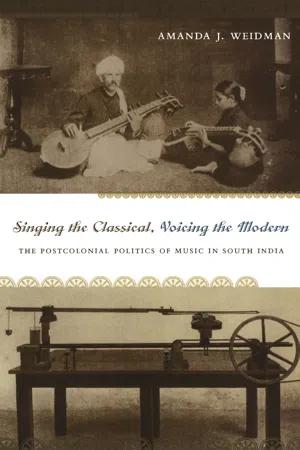
Singing the Classical, Voicing the Modern
The Postcolonial Politics of Music in South India
- English
- PDF
- Available on iOS & Android
Singing the Classical, Voicing the Modern
The Postcolonial Politics of Music in South India
About This Book
While Karnatic music, a form of Indian music based on the melodic principle of raga and time cycles called tala, is known today as South India's classical music, its status as "classical" is an early-twentieth-century construct, one that emerged in the crucible of colonial modernity, nationalist ideology, and South Indian regional politics. As Amanda J. Weidman demonstrates, in order for Karnatic music to be considered classical music, it needed to be modeled on Western classical music, with its system of notation, composers, compositions, conservatories, and concerts. At the same time, it needed to remain distinctively Indian. Weidman argues that these contradictory imperatives led to the emergence of a particular "politics of voice, " in which the voice came to stand for authenticity and Indianness.
Combining ethnographic observation derived from her experience as a student and performer of South Indian music with close readings of archival materials, Weidman traces the emergence of this politics of voice through compelling analyses of the relationship between vocal sound and instrumental imitation, conventions of performance and staging, the status of women as performers, debates about language and music, and the relationship between oral tradition and technologies of printing and sound reproduction. Through her sustained exploration of the way "voice" is elaborated as a trope of modern subjectivity, national identity, and cultural authenticity, Weidman provides a model for thinking about the voice in anthropological and historical terms. In so doing, she shows that modernity is characterized as much by particular ideas about orality, aurality, and the voice as it is by regimes of visuality.
Frequently asked questions
Information
Table of contents
- Contents
- List of Illustrations
- Acknowledgments
- Note on Transliteration and Spelling
- Introduction
- 1. Gone Native?: Travels of the Violin in South India
- 2. From the Palace to the Street: Staging ‘‘Classical’’ Music
- 3. Gender and the Politics of Voice
- 4. Can the Subaltern Sing?: Music, Language, and the Politics of Voice
- 5. A Writing Lesson: Musicology and the Birth of the Composer
- 6. Fantastic Fidelities
- Afterword: Modernity and the Voice
- Notes
- Works Cited
- Index